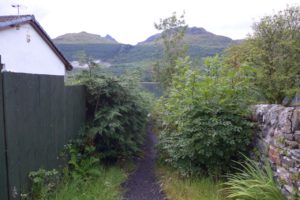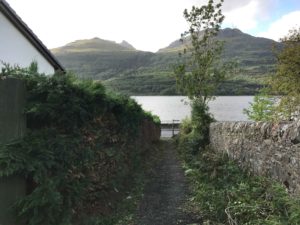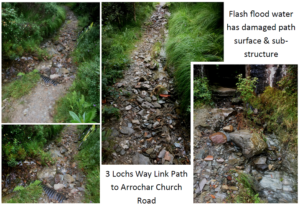

Following my post on lessons for path investment from the Dolomites I am pleased to report that the short link path to the Three Lochs Way at Arrochar has been cleared of vegetation by the West Dunbartonshire Community Payback Team. Well done to them and to the volunteers who asked them to help!

That the Loch Lomond and National Park Authority needs to work with all interests to develop a proper strategy for footpath maintenance in the National Park is illustrated by these photos which were sent to me by Duncan Maclachan of the Arrochar and Tarbet Community Development Trust. While the path by the church has been cleared, the surface of the Three Lochs Way above it has been eroded away by the recent rain and now needs urgent maintenance and possibly an alternative design to prevent small stones and gravel being flushed off into the water course in future.
The Three Lochs Way is an important recreational resource which runs from Balloch to Inveruglas and is “managed and maintained by the voluntary efforts of members of Helensburgh & District Access Trust” http://threelochsway.co.uk/. It was their Secretary who contacted the Community Payback Team to clear the path by Arrochar church. While they have been very good at raising money – a credit to all those involved – this requires constant effort and those volunteers will now have to try and find a way to repair the latest damage to the link path.
It may be a surprise to readers to learn that although much of the Three Lochs Way passes through the National Park, it gets no funding currently from the LLTNPA for maintenance purposes (although the upper section of the link path was originally completely funded by the National Park):
Our Funding Partners






Moreover, nor is the Three Lochs Way or the local Community at Arrochar able to call on anyone from the LLTNPA to assess and advise what work needs to be done on path maintenance either in this case or more generally. Local councils employ road specialists, but our National Park Authorities don’t employ path specialists despite the critical role that paths play in public enjoyment of the countryside. Instead, the NPAs rely on the Outdoor Access Trust (formerly the Cairngorms Outdoor Access Trust) which provides professional consultancy services which local communities and volunteers would need to pay for.
This is not just a problem for Arrochar, its a problem faced by local communities across out National Park. The Wildcat Trail at Newtonmore, for example, faces similar challenges. What is happening that due to a lack of resources our National Park Authorities, while saying all the right words about local community initiatives, are not providing the infrastructure necessary to support these properly.
Local communities have responded by trying to find their own solutions. At Arrochar and a number of other places in our National Parks this is through the development of local community hydro schemes http://arrocharhydro.coop/. While this could offer a potential source of funds for pathwork in future, it seems to me wrong that the LLTNPA appears to be leaving this all to local communities (at least the Chief Executive of the Cairngorms National Park Authority has flagged up the need for proper resources). The LLTNPA has a statutory responsibility to promote public enjoyment of the countryside and this means that it has overall responsibility for ensuring the path network is fit for purpose and properly maintained. Addressing these issues should be one of the key priorities of the next National Park Partnership Plan.
There are various models for doing this. I am not against either volunteers having key roles – we need stronger local democracy and people who serve on community councils all do so in a voluntary capacity and should be able to take more decisions – and there is also a place for Community Payback Schemes, training schemes for unemployed people etc. However, this needs to be underpinned by a professional resource, with the expertise both to design and construct paths according to the highest standards and through funding being available. Its the responsibility of our National Park Authorities to ensure these resources are in place.
